+ Open data
Open data
- Basic information
Basic information
| Entry | Database: PDB / ID: 1yej | ||||||
|---|---|---|---|---|---|---|---|
| Title | CATALYTIC ANTIBODY COMPLEX | ||||||
 Components Components |
| ||||||
 Keywords Keywords | IMMUNE SYSTEM / ABZYME / TRANSITION STATE ANALOG | ||||||
| Function / homology |  Function and homology information Function and homology informationimmunoglobulin complex / adaptive immune response / extracellular region / metal ion binding / plasma membrane Similarity search - Function | ||||||
| Biological species |  | ||||||
| Method |  X-RAY DIFFRACTION / X-RAY DIFFRACTION /  SYNCHROTRON / SYNCHROTRON /  MOLECULAR REPLACEMENT / Resolution: 1.85 Å MOLECULAR REPLACEMENT / Resolution: 1.85 Å | ||||||
 Authors Authors | Gigant, B. / Knossow, M. | ||||||
 Citation Citation |  Journal: J.Mol.Biol. / Year: 1998 Journal: J.Mol.Biol. / Year: 1998Title: Crossreactivity, efficiency and catalytic specificity of an esterase-like antibody. Authors: Gigant, B. / Charbonnier, J.B. / Eshhar, Z. / Green, B.S. / Knossow, M. | ||||||
| History |
|
- Structure visualization
Structure visualization
| Structure viewer | Molecule:  Molmil Molmil Jmol/JSmol Jmol/JSmol |
|---|
- Downloads & links
Downloads & links
- Download
Download
| PDBx/mmCIF format |  1yej.cif.gz 1yej.cif.gz | 103.7 KB | Display |  PDBx/mmCIF format PDBx/mmCIF format |
|---|---|---|---|---|
| PDB format |  pdb1yej.ent.gz pdb1yej.ent.gz | 78.1 KB | Display |  PDB format PDB format |
| PDBx/mmJSON format |  1yej.json.gz 1yej.json.gz | Tree view |  PDBx/mmJSON format PDBx/mmJSON format | |
| Others |  Other downloads Other downloads |
-Validation report
| Summary document |  1yej_validation.pdf.gz 1yej_validation.pdf.gz | 442.2 KB | Display |  wwPDB validaton report wwPDB validaton report |
|---|---|---|---|---|
| Full document |  1yej_full_validation.pdf.gz 1yej_full_validation.pdf.gz | 447.4 KB | Display | |
| Data in XML |  1yej_validation.xml.gz 1yej_validation.xml.gz | 11.3 KB | Display | |
| Data in CIF |  1yej_validation.cif.gz 1yej_validation.cif.gz | 17.6 KB | Display | |
| Arichive directory |  https://data.pdbj.org/pub/pdb/validation_reports/ye/1yej https://data.pdbj.org/pub/pdb/validation_reports/ye/1yej ftp://data.pdbj.org/pub/pdb/validation_reports/ye/1yej ftp://data.pdbj.org/pub/pdb/validation_reports/ye/1yej | HTTPS FTP |
-Related structure data
| Related structure data | 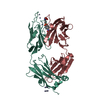 1yeiC 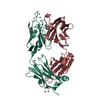 1yekC 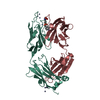 1yecS S: Starting model for refinement C: citing same article ( |
|---|---|
| Similar structure data |
- Links
Links
- Assembly
Assembly
| Deposited unit | 
| ||||||||
|---|---|---|---|---|---|---|---|---|---|
| 1 |
| ||||||||
| Unit cell |
|
- Components
Components
| #1: Antibody | Mass: 24019.842 Da / Num. of mol.: 1 / Fragment: ANTIGEN BINDING FRAGMENT / Source method: isolated from a natural source / Source: (natural)  | ||||||||
|---|---|---|---|---|---|---|---|---|---|
| #2: Antibody | Mass: 24189.217 Da / Num. of mol.: 1 / Fragment: ANTIGEN BINDING FRAGMENT / Source method: isolated from a natural source / Source: (natural)  | ||||||||
| #3: Chemical | ChemComp-ZN / #4: Chemical | ChemComp-PNF / | #5: Water | ChemComp-HOH / | Has protein modification | Y | Sequence details | THE SEQUENCES OF THE CONSTANT DOMAINS OF THE HEAVY CHAINS. (RESIDUES H106 - H223) AND OF THE LIGHT ...THE SEQUENCES OF THE CONSTANT DOMAINS OF THE HEAVY CHAINS. (RESIDUES H106 - H223) AND OF THE LIGHT CHAINS (RESIDUES L107 - L214) HAVE NOT BEEN DETERMINED | |
-Experimental details
-Experiment
| Experiment | Method:  X-RAY DIFFRACTION / Number of used crystals: 1 X-RAY DIFFRACTION / Number of used crystals: 1 |
|---|
- Sample preparation
Sample preparation
| Crystal | Density Matthews: 2.91 Å3/Da / Density % sol: 57 % | |||||||||||||||||||||||||
|---|---|---|---|---|---|---|---|---|---|---|---|---|---|---|---|---|---|---|---|---|---|---|---|---|---|---|
| Crystal grow | Method: vapor diffusion, hanging drop / pH: 7.5 Details: PRECIPITANT: 30% (W/V) PEG 600, 100MM CACODYLATE PH7.5, 40MM ZN ACETATE, VAPOR DIFFUSION, HANGING DROP | |||||||||||||||||||||||||
| Crystal | *PLUS | |||||||||||||||||||||||||
| Crystal grow | *PLUS Temperature: 18 ℃ | |||||||||||||||||||||||||
| Components of the solutions | *PLUS
|
-Data collection
| Diffraction | Mean temperature: 278 K |
|---|---|
| Diffraction source | Source:  SYNCHROTRON / Site: LURE SYNCHROTRON / Site: LURE  / Beamline: DW32 / Wavelength: 0.98 / Beamline: DW32 / Wavelength: 0.98 |
| Detector | Type: MARRESEARCH / Detector: IMAGE PLATE / Date: Jul 12, 1996 / Details: BENT MIRROR |
| Radiation | Monochromator: GRAPHITE / Protocol: SINGLE WAVELENGTH / Monochromatic (M) / Laue (L): M / Scattering type: x-ray |
| Radiation wavelength | Wavelength: 0.98 Å / Relative weight: 1 |
| Reflection | Resolution: 1.85→10 Å / Num. obs: 46997 / % possible obs: 96.9 % / Observed criterion σ(I): 1 / Redundancy: 2.2 % / Rsym value: 0.065 / Net I/σ(I): 17.1 |
| Reflection shell | Resolution: 1.85→1.92 Å / Redundancy: 2.2 % / Mean I/σ(I) obs: 2.65 / Rsym value: 0.404 / % possible all: 98.8 |
| Reflection | *PLUS Num. measured all: 105615 / Rmerge(I) obs: 0.065 |
| Reflection shell | *PLUS % possible obs: 98.8 % / Rmerge(I) obs: 0.404 |
- Processing
Processing
| Software |
| ||||||||||||||||||||||||||||||||||||||||||||||||||||||||||||
|---|---|---|---|---|---|---|---|---|---|---|---|---|---|---|---|---|---|---|---|---|---|---|---|---|---|---|---|---|---|---|---|---|---|---|---|---|---|---|---|---|---|---|---|---|---|---|---|---|---|---|---|---|---|---|---|---|---|---|---|---|---|
| Refinement | Method to determine structure:  MOLECULAR REPLACEMENT MOLECULAR REPLACEMENTStarting model: 1YEC Resolution: 1.85→7 Å / Cross valid method: THROUGHOUT / σ(F): 2
| ||||||||||||||||||||||||||||||||||||||||||||||||||||||||||||
| Displacement parameters | Biso mean: 28 Å2 | ||||||||||||||||||||||||||||||||||||||||||||||||||||||||||||
| Refine analyze | Luzzati d res low obs: 7 Å / Luzzati sigma a obs: 0.24 Å | ||||||||||||||||||||||||||||||||||||||||||||||||||||||||||||
| Refinement step | Cycle: LAST / Resolution: 1.85→7 Å
| ||||||||||||||||||||||||||||||||||||||||||||||||||||||||||||
| Refine LS restraints |
| ||||||||||||||||||||||||||||||||||||||||||||||||||||||||||||
| LS refinement shell | Resolution: 1.85→1.93 Å / Total num. of bins used: 8
| ||||||||||||||||||||||||||||||||||||||||||||||||||||||||||||
| Software | *PLUS Name:  X-PLOR / Version: 3.843 / Classification: refinement X-PLOR / Version: 3.843 / Classification: refinement | ||||||||||||||||||||||||||||||||||||||||||||||||||||||||||||
| Refinement | *PLUS Lowest resolution: 7 Å / σ(F): 2 / % reflection Rfree: 5 % | ||||||||||||||||||||||||||||||||||||||||||||||||||||||||||||
| Solvent computation | *PLUS | ||||||||||||||||||||||||||||||||||||||||||||||||||||||||||||
| Displacement parameters | *PLUS Biso mean: 28 Å2 | ||||||||||||||||||||||||||||||||||||||||||||||||||||||||||||
| Refine LS restraints | *PLUS
| ||||||||||||||||||||||||||||||||||||||||||||||||||||||||||||
| LS refinement shell | *PLUS Rfactor Rfree: 0.313 / % reflection Rfree: 5 % / Rfactor Rwork: 0.304 / Rfactor obs: 0.304 |
 Movie
Movie Controller
Controller



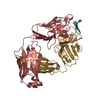
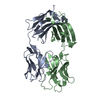



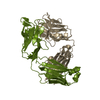


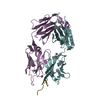


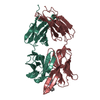

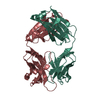
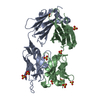

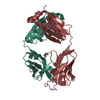
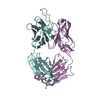


 PDBj
PDBj






